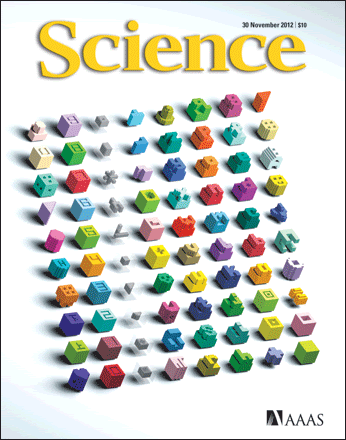 The first IMBIE assessment was published in 2012, showing that between 1992 and 2011, the ice sheets contributed 0.6 mm/yr to the rate of global sea-level rise. By combining an ensemble of satellite altimetry, interferometry, and gravimetry datasets using common geographical regions, time intervals, and models of surface mass balance and glacial isostatic adjustment to estimate the mass balance of Earth’s polar ice sheets, we demonstrated that there is a good agreement between the different satellite methods. Further, we showed that combining multiple satellite datasets led to a greater certainty in the measurements of Antarctica and Greenland mass balance.
The first IMBIE assessment was published in 2012, showing that between 1992 and 2011, the ice sheets contributed 0.6 mm/yr to the rate of global sea-level rise. By combining an ensemble of satellite altimetry, interferometry, and gravimetry datasets using common geographical regions, time intervals, and models of surface mass balance and glacial isostatic adjustment to estimate the mass balance of Earth’s polar ice sheets, we demonstrated that there is a good agreement between the different satellite methods. Further, we showed that combining multiple satellite datasets led to a greater certainty in the measurements of Antarctica and Greenland mass balance.
Shepherd et al. 2012. A reconciled estimate of ice sheet mass balance. Science, 338(6111), pp.1183-1189. (link)
 In 2018, we published an updated assessment of the mass balance of Antarctica. We found that between 1992 and 2017, the Antarctic Ice Sheet lost 2720 billion tonnes of ice, contributing 7.6 mm to global mean sea-level rise. This record of Antarctica mass changes shows that while prior to 2012, Antarctica lost ice at a steady rate of 76 billion tonnes per year, it is now losing ice faster than ever, with more than half of the total ice loss occurring between 2012 and 2017. This increase in ice loss from the continent as a whole is a combination of glacier speedup in West Antarctica and at the Antarctic Peninsula, and reduced growth of the ice sheet in East Antarctica.
In 2018, we published an updated assessment of the mass balance of Antarctica. We found that between 1992 and 2017, the Antarctic Ice Sheet lost 2720 billion tonnes of ice, contributing 7.6 mm to global mean sea-level rise. This record of Antarctica mass changes shows that while prior to 2012, Antarctica lost ice at a steady rate of 76 billion tonnes per year, it is now losing ice faster than ever, with more than half of the total ice loss occurring between 2012 and 2017. This increase in ice loss from the continent as a whole is a combination of glacier speedup in West Antarctica and at the Antarctic Peninsula, and reduced growth of the ice sheet in East Antarctica.
The IMBIE Team. 2018. Mass balance of the Antarctic ice sheet from 1992 to 2017. Nature, 558(7709), pp.219-222. (link)
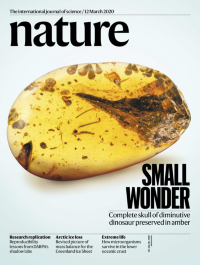 In 2019, we published an updated assessment of the mass balance of Greenland. We found that between 1992 and 2018, the Greenland Ice Sheet lost 3902 billion tonnes of ice, contributing 10.8 mm to global mean sea-level rise. Although Greenland has been losing ice since the early 1990s, annual losses have risen since then, with the rate of mass loss rising from 33 billion tonnes per year to 254 billion tonnes per year in the last decade – a seven-fold increase. Further, we found that half of the ice losses were due to surface melting as air temperatures have risen and half were attributed to increased glacier flow, triggered by rising ocean temperatures.
In 2019, we published an updated assessment of the mass balance of Greenland. We found that between 1992 and 2018, the Greenland Ice Sheet lost 3902 billion tonnes of ice, contributing 10.8 mm to global mean sea-level rise. Although Greenland has been losing ice since the early 1990s, annual losses have risen since then, with the rate of mass loss rising from 33 billion tonnes per year to 254 billion tonnes per year in the last decade – a seven-fold increase. Further, we found that half of the ice losses were due to surface melting as air temperatures have risen and half were attributed to increased glacier flow, triggered by rising ocean temperatures.
The IMBIE Team. 2019. Mass balance of the Greenland Ice Sheet from 1992 to 2018. Nature, 579(7798), pp.233-239. (link)
The IMBIE past assessments have also been used to outline the importance of providing robust ice sheet mass balance estimates, in particular to improve predictions of the ice sheets’ contribution to global sea-level rise:
Antarctica and Greenland mass change is the most uncertain source of sea-level rise and thus developing ice-sheet models able to closely reproduce satellite observations of ice sheet mass loss is key to better predict sea-level rise. During the past decade, new satellite missions and refined processing methods of satellite data have contributed to the production of a large number of satellite-based ice sheet mass balance estimates. By combining these observations into a single reconciled estimate, IMBIE demonstrated that when using a common framework, these observations agree within their respective uncertainties, showing a three-fold increase in ice losses from Antarctica and Greenland over the satellite era. Similarly, ice sheet models have been significantly improved for the IPCC Fifth Assessment Report, with the development of a new generation of ice sheet models capable of reproducing the rapid ice dynamical response of the ice sheets apparent in satellite observations. Together, satellite observations and ice sheet models can help better predict sea-level rise.
Shepherd, A. and S. Nowicki. 2017. Improvements in ice-sheet sea-level projections. Nature Climate Change, 7(10), pp.672-674. (link)
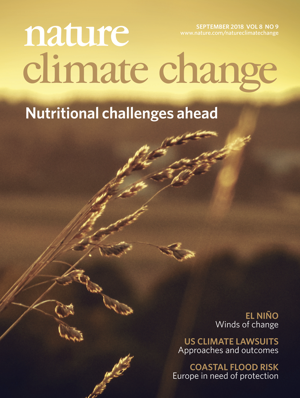 While ice sheet models have been greatly improved for the IPCC Fifth Assessment Report, a comparison between the IPCC projected sea level contribution of Antarctica and the IMBIE assessment shows that during their 10-year overlap period, satellite observations were 30 times greater than the IPCC’s lower estimates – closest to the upper range of the IPCC estimates. If this trajectory is followed, Antarctica will contribute 151 mm to global mean sea level rise by 2100m, which needs to be taken into account when designing strategies to prepare for future climate change.
While ice sheet models have been greatly improved for the IPCC Fifth Assessment Report, a comparison between the IPCC projected sea level contribution of Antarctica and the IMBIE assessment shows that during their 10-year overlap period, satellite observations were 30 times greater than the IPCC’s lower estimates – closest to the upper range of the IPCC estimates. If this trajectory is followed, Antarctica will contribute 151 mm to global mean sea level rise by 2100m, which needs to be taken into account when designing strategies to prepare for future climate change.
Slater, T. and A. Shepherd. 2018. Antarctic ice losses tracking high. Nature Climate Change, 8(12), pp.1025-1026. (link)
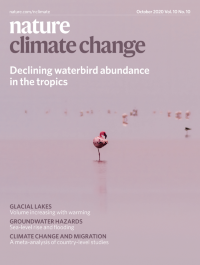 Comparing the IMBIE assessments of Greenland and Antarctica mass change to the IPCC Fifth Assessment Report (AR5) sea-level predictions shows that observed ice-sheet losses track the upper range of the sea-level predictions during their 10-year overlap (2007-2017). These upper-estimates predict an additional 17.9 mm of sea-level rise from the ice sheets above the central predictions by 2100, which would put 50 million people at risk of coastal flooding. This comparison also shows that the high inter-annual variability in Greenland surface mass balance and in Antarctica dynamic ice losses are not reproduced in AR5, and that ice-sheet models must account for this short-term variability in order to accurately predict sea-level rise.
Comparing the IMBIE assessments of Greenland and Antarctica mass change to the IPCC Fifth Assessment Report (AR5) sea-level predictions shows that observed ice-sheet losses track the upper range of the sea-level predictions during their 10-year overlap (2007-2017). These upper-estimates predict an additional 17.9 mm of sea-level rise from the ice sheets above the central predictions by 2100, which would put 50 million people at risk of coastal flooding. This comparison also shows that the high inter-annual variability in Greenland surface mass balance and in Antarctica dynamic ice losses are not reproduced in AR5, and that ice-sheet models must account for this short-term variability in order to accurately predict sea-level rise.
Slater, T., A. E. Hogg and R. Mottram. 2020. Ice-sheet losses track high-end sea-level rise projections. Nature Climate Change, 10(10), pp.879-881. (link)
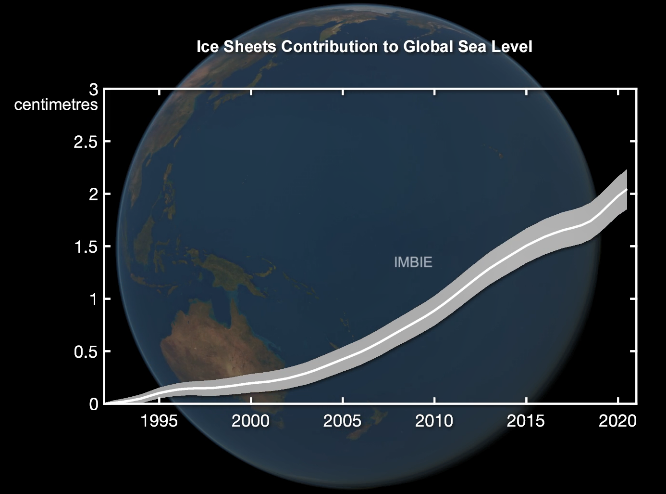
In 2023, we published a new assessment of Greenland and Antarctica mass balance in Earth System Science Data, covering the period 1992 to 2020. In this third IMBIE assessment, we combined 50 satellite surveys of Antarctica and Greenland to determine their rate of ice melting. Between 1992 and 2020, Earth’s polar ice sheets lost 7,560 billion tonnes of ice – equivalent to an ice cube that would be 20 kilometres in height. The polar ice sheets have together lost ice in every year of the satellite record, and the seven highest melting years have occurred in the past decade. Importantly, this assessment brings the IMBIE records of ice loss from Antarctica and Greenland in line, using the same methods and covering the same period in time.
Otosaka, I. N., Shepherd, A., Ivins, E. R., Schlegel, N.-J., Amory, C., van den Broeke, M. R., Horwath, M., Joughin, I., King, M. D., Krinner, G., Nowicki, S., Payne, A. J., Rignot, E., Scambos, T., Simon, K. M., Smith, B. E., Sørensen, L. S., Velicogna, I., Whitehouse, P. L., A, G., Agosta, C., Ahlstrøm, A. P., Blazquez, A., Colgan, W., Engdahl, M. E., Fettweis, X., Forsberg, R., Gallée, H., Gardner, A., Gilbert, L., Gourmelen, N., Groh, A., Gunter, B. C., Harig, C., Helm, V., Khan, S. A., Kittel, C., Konrad, H., Langen, P. L., Lecavalier, B. S., Liang, C.-C., Loomis, B. D., McMillan, M., Melini, D., Mernild, S. H., Mottram, R., Mouginot, J., Nilsson, J., Noël, B., Pattle, M. E., Peltier, W. R., Pie, N., Roca, M., Sasgen, I., Save, H. V., Seo, K.-W., Scheuchl, B., Schrama, E. J. O., Schröder, L., Simonsen, S. B., Slater, T., Spada, G., Sutterley, T. C., Vishwakarma, B. D., van Wessem, J. M., Wiese, D., van der Wal, W., and Wouters, B.: Mass balance of the Greenland and Antarctic ice sheets from 1992 to 2020, Earth Syst. Sci. Data, 15, 1597–1616, https://doi.org/10.5194/essd-15-1597-2023, 2023. (link)



